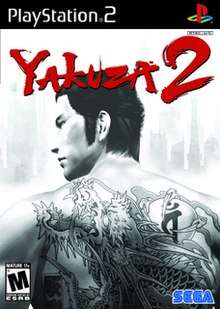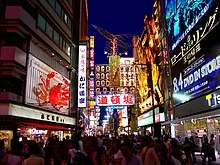Yakuza 2
| Yakuza 2 | |
|---|---|
 | |
| Developer(s) | Sega |
| Publisher(s) | Sega |
| Director(s) | Ryuta Ueda |
| Producer(s) | Masayoshi Kikuchi |
| Designer(s) | Daisuke Sato |
| Programmer(s) |
Tetsuya Kaku Koji Tokieda |
| Artist(s) | Daisuke Sato |
| Writer(s) |
Masayoshi Yokoyama Makoto Itakura Seishu Hase |
| Composer(s) |
Hidenori Shoji Hideki Sakamoto Norihiko Hibino Takahiro Izutani |
| Series | Yakuza |
| Platform(s) |
PlayStation 2 PlayStation 3 Wii U |
| Release |
PlayStation 2PlayStation 3
|
| Genre(s) | Action-adventure |
| Mode(s) | Single-player |
Yakuza 2 (Japanese: 龍が如く2 Hepburn: Ryū ga Gotoku 2, "Like a Dragon 2") is an action-adventure game by Sega, the sequel to Yakuza. It was released on December 7, 2006, for the PlayStation 2 in Japan and in September 2008 in North America and Europe.[1] The game focuses on the former yakuza Kazuma Kiryu who receives a request for help from his former group, the Tojo Clan, to keep relationships with the eastern group, the Omi Family, stable. Across Kazuma's journey he learns of a Korean mafia group linked with the Omi Family and becomes the rival of the Omi's "Kansai Dragon", Ryuji Goda.
Yakuza 2 has several gameplay features over its predecessor. Sega wished to improve the fighting engine based on fan input to provide a more rich experience. The story was aimed to feature a deep adult love story, something not seen in the previous game. Additionally, for the western versions the original Japanese audio was kept in contrast to the previous game which contained English audio.
Critical reception to Yakuza 2 was positive, with reviewers praising the presentation and fighting system. A PlayStation 4 remake of the game, Yakuza Kiwami 2, was released in 2017.
Plot
Setting
Half of the game takes place in Tokyo's Shinjuku ward, most noticeably a recreation of Shinjuku's red-light district Kabukichō renamed Kamurocho.
The other half takes place in Osaka, with the fictitious Sōtenbori and Shinseicho areas modeled after Osaka's respectively Dōtonbori and Shinsekai districts. Although these areas were recreated as fictionalized versions, many real life landmarks remain such as Dōtonbori's Sammy Ebisu Plaza (サミー戎プラザ) and Shinsekai's Tsutenkaku Tower (通天閣) and Billiken (ビリケン).
Story
A year after leaving his former life in the Tojo Clan behind, ex-yakuza Kazuma Kiryu is called back into action when the clan's Fifth Chairman, Yukio Terada, is murdered by assassins from a rival organization, the Omi Alliance. Returning to Kamurocho, Kiryu must find a new chairman for the Tojo Clan and prevent an all-out war between the Tojo and the Omi, bringing him into conflict with Ryuji Goda, the legendary "Dragon Of Kansai" of the Omi Alliance.
Development
Yakuza 2 was announced in August 2006 with Sega promising an improved fighting system and further exploration.[2] Nagoshi commented on some of his goals with Yakuza 2. In addition to providing a deeper dramatic storyline over what was found in the original, the game also has some themes that were not in the original, including an adult love story.[3] The Sega team considered fan input when making changes to Yakuza 2. One of the main aims in developing Yakuza 2 was improving its fighting engine. Accounting for fights against multiple opponents was one of the most important things that were considered when improving the fighting engine. It was made much easier, for instance, to attack foes that come at the player character from multiple directions, and to switch targets in the middle of a combo in order to quickly take out someone who may have snuck up on your flank. As a result, the fighting system was polished and the staff believed they succeeded. In localizing the game, the Japanese audio was kept instead of producing an English dub. This proved no difficulties.[4] The team also added more Heat moves to make the fights more exciting.[5]
The director of the voice recordings discouraged the voice actors from falling back on the cliches of anime character acting. When scenes involving characters exchanging insults and threatening each other take on cartoon cadences, the sense of tension and suspense evaporates. The decision not to use an overblown style of acting was what the composer thought it added to the distinctive dramatic feel of the series.[6] This is the first game in the series to feature only Japanese voice acting for its U.S. and PAL release as a response to the criticism of the English voice acting in the first game.[7][8]
Soundtrack
The Ryū ga Gotoku & Ryū ga Gotoku 2 Original Sound Track (HCV-287) dual-disc boxset was published by Wave Master in Japan on January 25, 2007.[9] The music was composed by Hidenori Shoji, Hideki Sakamoto Norihiko Hibino and Takahiro Izutani. During the development of Super Monkey Ball: Banana Blitz for the Wii, Sega sound manager Haruyoshi Tomita became interested in the company's approach to sound design. As it so happened, Sakamoto was a huge fan of the original Yakuza game title, so being commissioned for the sequel was not the kind of offer that he was about to pass up. Shoji had developed a stimulating guitar sound for the game, so he was interested in seeing what he could do with piano compositions. His use of instruments and editing techniques offered ample resources for him to study upon entering the production side of the series. His own compositional style has its roots in classical music, which might be one distinction that helped differentiate their musical approaches. To write music that complements the compelling depth of the narrative, it was necessary to proceed from the point of view of bridging the gap between the scenarist and the player.[6]
As with the first game a classic gospel, this time Franz Gruber's Silent Night, Holy Night (Stille Nacht, heilige Nacht), is sung in English by Eri Kawai.[10] Singer So Yoki performs Kamuro Setsugekka (神室雪月花).
Marketing
In order to make realistic recreations of Tokyo's Kabukicho and Osaka's Dōtonbori, Sega made 17 tie-in with famous Japanese companies.[11] As a result, some places found in the game, such as the Don Quijote discount store, the Club Sega game centers and the Matsuya (松屋) restaurants (replacing its unlicensed version called Akagyu) are modeled after the real life buildings. The Tōkaidō Shinkansen high-speed train is also featured in the game.
In order to support the game's expensive production, Sega used product placement strategy and introduced ads within the game. This includes the Japanese coffee brand Boss Coffee, numerous brands of alcohol appearing in the game's bars and pubs including Suntory Whiskey, Jack Daniel's Bourbon or Carlsberg Beer.
Famous real life arcades are included in the game.[5] Sega's UFO Catcher crane game machine is included as a minigame, and arcade cabinets of Virtua Fighter 4 can be seen in the Club Sega game centers.
Reception
| Reception | ||||||||||||||||||||||||||
|---|---|---|---|---|---|---|---|---|---|---|---|---|---|---|---|---|---|---|---|---|---|---|---|---|---|---|
| ||||||||||||||||||||||||||
Yakuza 2 was the 98th best-selling game in Japan in 2008 selling 136,809 copies that year,[21] while it was the third best-selling PlayStation 2 game in its release year, 2006, reaching lifetime sales of around 830,000 in Japan.[22][23] 40,000 copies were sold in North America.[24]
Famitsu gave the game a score of 38 out of 40.[15] IGN gave Yakuza 2 a score of 8.5 out of 10,[19] and GameFan gave the game a score of Very Good,[16] as well as their 'Best PlayStation 2 Game' award for 2008.[25] Eurogamer rated the game 8 out of 10.[14]
Releases
The Japanese version of the game, Ryū Ga Gotoku 2, was ported to the PlayStation 3 and Wii U consoles. This remastered edition of the second game in the series is bundled with the original Japanese version of the first game. Both compilations were released in Japan.
PlayStation 3
On November 1, 2012, a PlayStation 3 HD remaster of the Japanese original version of Yakuza and Yakuza 2 titled Ryu Ga Gotoku 1&2 HD edition was released in Japan.[26] This "HD edition" features both game remasters bundled in a single Blu-ray disc and later in a ~19GB downloadable file.
On December 11, 2014, this "HD edition" was re-released in the budget range "PlayStation 3 the Best" dedicated to best sellers on the Japanese domestic market.[27] Simultaneously to this Blu-ray re-release, a 18.1GB[28] downloadable version was also made available for purchase on the Japanese PlayStation Store.[29]
Wii U
On August 8, 2013, a Wii U HD remaster of the Japanese original version of Yakuza and Yakuza 2 titled Ryu Ga Gotoku 1&2 HD for Wii U was released in Japan.[30] This "HD for Wii U" release features both game remasters bundled in a single disc or in a 19.8GB[31] file for download. This Wii U release is notable for being the first port of the PlayStation-exclusive Yakuza series on a non-Sony platform.
Yakuza Kiwami 2
A remake of Yakuza 2, titled Yakuza Kiwami 2, was released on December 7, 2017 in Japan for PlayStation 4, and will be released worldwide on August 28, 2018. This remake is built on the Dragon Engine previously used in Yakuza 6: The Song of Life. Similar to 2016's Yakuza: Kiwami, the remake adds new elements not seen in the previous release, including a new playable story campaign for Goro Majima that continues story threads for the character that began in Yakuza 0.
References
- ↑ Yakuza 2 release dates
- ↑ "Ryu Ga Gotoku (Yakuza) 2 in the works". Siliconera.
- ↑ "Yakuza Sequel Announced". IGN.
- ↑ "Sega tells us why they kept the Japanese voice track in Yakuza 2". Siliconera.
- 1 2 "E3 2008: Interview". GameTrailers.
- 1 2 the_miker (September 20, 2008). "Yakuza 2 Music Interview – Hidenori Shoji and Hideki Sakamoto". Siliconera. Archived from the original on March 1, 2014. Retrieved May 11, 2014.
- ↑ Ashcraft, Brian (2008-09-05). "SEGA Explains Yakuza 2's Japanese Voices". Kotaku. Retrieved 2008-10-20.
- ↑ Spencer (2008-09-04). "SEGA Explains Yakuza 2's Japanese Voices". CraveOnline. Retrieved 2008-10-20.
- ↑ Yakuza & Yakuza 2 OST - official webpage
- ↑ the_miker (2007-11-24). "Ryu ga Gotoku & Ryu ga Gotoku 2 Original Sound Track". VGMdb. Retrieved 2008-07-24.
- ↑ Ryu Ga Gotoku 2 official Website
- ↑ "Yakuza 2 for PlayStation 2 Reviews - Metacritic". Metacritic. 2008-09-09. Retrieved 2016-06-26.
- ↑ Nguyen, Thierry (2008-09-17). "Yakuza 2 Review for PS2, PS3 from". 1UP.com. Archived from the original on 2012-08-01. Retrieved 2012-07-07.
- 1 2 Reed, Kristan (2008-09-19). "Yakuza 2 Review • Page • Reviews • PlayStation 2 •". Eurogamer.net. Retrieved 2012-07-07.
- 1 2 Archived December 10, 2006, at the Wayback Machine.
- 1 2 "Review: Yakuza 2 (PS2)". Diehard GameFAN. 2008-09-25. Retrieved 2012-07-07.
- ↑ September 22, 2008 6:12PM PDT (2008-09-09). "Yakuza 2 Review". GameSpot.com. Retrieved 2012-07-07.
- ↑ Archived March 26, 2010, at the Wayback Machine.
- 1 2 var authorId = "41672334" by Sam Bishop. "Yakuza 2 Review - PlayStation 2 Review at IGN". Ps2.ign.com. Retrieved 2012-07-07.
- ↑ Mitchell, Richard. "Joystiq". Gamedaily.com. Retrieved 2012-07-07.
- ↑ "2008 top 100". Kyoto.zaq.ne.jp. Archived from the original on 2009-02-24. Retrieved 2009-01-21.
- ↑ "GrID S565 - PS2 2006 Releases". garaph.info. Retrieved June 26, 2012.
- ↑ "GID 2690 - Yakuza 2 (PlayStation 2 The Best) - PS2". garaph.info. Retrieved June 26, 2012.
- ↑ "Yakuza 3 won't go west, says SEGA News". Eurogamer. 2009-07-30. Retrieved 2009-08-06.
- ↑ Dieheard GameFAN's 2008 Gaming Awards
- ↑ 龍が如く1&2 HD EDITION PlayStation®3 the Best, PlayStation official website - Japan
- ↑ 龍が如く1&2 HD EDITION PlayStation®3 the Best, PlayStation official website - Japan
- ↑ 龍が如く 1&2 HD EDITION PlayStation®3 the Best, PlayStation Store - Japan
- ↑ 龍が如く1&2 HD EDITION PlayStation®3 the Best, PlayStation official website - Japan
- ↑ Ryu Ga Gotoku 1&2 HD for Wii official website
- ↑ 龍が如く1&2 HD for Wii U, Nintendo official website - Japan
